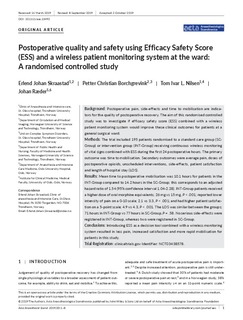| dc.contributor.author | Skraastad, Erlend Johan | |
| dc.contributor.author | Borchgrevink, Petter Chr. | |
| dc.contributor.author | Nilsen, Tom Ivar Lund | |
| dc.contributor.author | Ræder, Johan | |
| dc.date.accessioned | 2019-12-20T12:08:18Z | |
| dc.date.available | 2019-12-20T12:08:18Z | |
| dc.date.created | 2019-12-03T15:36:30Z | |
| dc.date.issued | 2019 | |
| dc.identifier.issn | 0001-5172 | |
| dc.identifier.uri | http://hdl.handle.net/11250/2634288 | |
| dc.description.abstract | Background: Postoperative pain, side‐effects and time to mobilisation are indica‐tors for the quality of postoperative recovery. The aim of this randomised controlled study was to investigate if efficacy safety score (ESS) combined with a wireless patient monitoring system would improve these clinical outcomes for patients at a general surgical ward.Methods: The trial included 195 patients randomised to a standard care group (SC‐Group) or intervention group (INT‐Group) receiving continuous wireless monitoring of vital signs combined with ESS during the first 24 postoperative hours. The primary outcome was time to mobilisation. Secondary outcomes were average pain, doses of postoperative opioids, unscheduled interventions, side‐effects, patient satisfaction and length of hospital stay (LOS).Results: Mean time to postoperative mobilisation was 10.1 hours for patients in the INT‐Group compared to 14.2 hours in the SC‐Group; this corresponds to an adjusted hazard ratio of 1.54 (95% confidence interval 1.04‐2.28). INT‐Group patients received a higher dose of oral morphine equivalents; 26 mg vs 15 mg, P < .001; reported lower intensity of pain on a 0‐10 scale; 2.1 vs 3.3, P < .001; and had higher patient satisfac‐tion on a 5‐point scale; 4.9 vs 4.3, P < .001. The LOS was similar between the groups;71 hours in INT‐Group vs 77 hours in SC‐Group, P = .58. No serious side‐effects were registered in INT‐Group, whereas two were registered in SC‐Group.Conclusions: Introducing ESS as a decision tool combined with a wireless monitoring system resulted in less pain, increased satisfaction and more rapid mobilisation for patients in this study.Trial Registration: clini caltr ials.gov Identifier: NCT03438578. | nb_NO |
| dc.language.iso | eng | nb_NO |
| dc.publisher | Wiley | nb_NO |
| dc.rights | Navngivelse 4.0 Internasjonal | * |
| dc.rights.uri | http://creativecommons.org/licenses/by/4.0/deed.no | * |
| dc.title | Postoperative quality and safety using Efficacy Safety Score (ESS) and a wireless patient monitoring system at the ward: A randomised controlled study | nb_NO |
| dc.type | Journal article | nb_NO |
| dc.type | Peer reviewed | nb_NO |
| dc.description.version | publishedVersion | nb_NO |
| dc.source.journal | Acta Anaesthesiologica Scandinavica | nb_NO |
| dc.identifier.doi | 10.1111/aas.13492 | |
| dc.identifier.cristin | 1756220 | |
| dc.description.localcode | © 2019 This is an open access article under the terms of the Creative Commons Attribution License, which permits use, distribution and reproduction in any medium, provided the original work is properly cited. | nb_NO |
| cristin.unitcode | 194,65,25,0 | |
| cristin.unitcode | 1920,28,0,0 | |
| cristin.unitcode | 194,65,20,0 | |
| cristin.unitname | Institutt for sirkulasjon og bildediagnostikk | |
| cristin.unitname | Klinikk for anestesi og intensivmedisin | |
| cristin.unitname | Institutt for samfunnsmedisin og sykepleie | |
| cristin.ispublished | true | |
| cristin.fulltext | original | |
| cristin.qualitycode | 1 | |

